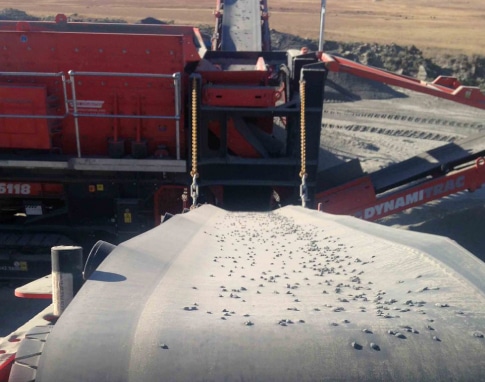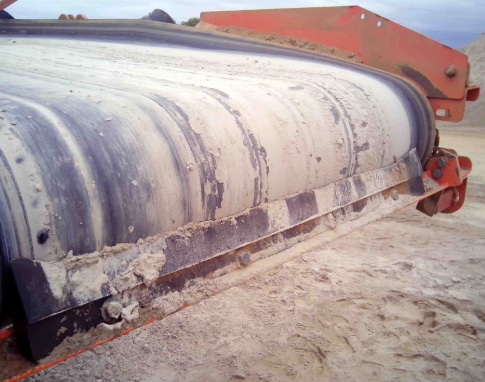Why is a belt scraper important?
A belt scraper is a vitally important component of a conveyor belt system that is often overlooked and neglected.
The primary purpose of the belt scraper is to prevent material carry back on the conveyor belt. By reducing material carry back, the conveyors can run more efficiently by having fewer breakdowns and lower running costs. Efficient and correctly adjusted belt scrapers save the plant operator money.
Missing or inefficient belt scrapers can cause safety hazards on site
Material carry back causes spillage under the conveyors, material build-up along the structures and moving parts. These problems lead to more serious issues.
Problems associated with poorly maintained belt scrapers include:
- Excessive build-up on rollers and pulleys
- Excessive wear on rollers and pulleys
- Misalignment of the conveyor belt due to artificial crowning on rollers
- Miss-tracking of the conveyor belt
- Conveyor belt top cover damage

Above images indicate excessive build-up
There are several safety hazards associated with material spillage and build-up on conveyors. Examples of this is material falling on people or vehicles to the inherent dangers when cleaning excessive build-up on conveyor structures and even the risk of fire due to miss-tracking and misalignment.
A well designed belt scraper will clean effectively, have a long wear life and require minimal maintenance.
The efficiency of a belt scraper is affected by several factors:
- The condition of the belt scraper blade
- The condition of the conveyor belt surface
- The belt scraper tension and adjustment
- The belt scraper material
- The type and condition of the belt splice
- The speed of the conveyor belt

This image indicates what an efficient scraper looks like

The above image shows an excessively worn scraper blade
The efficiency of belt scrapers should be monitored by the machine operator on a daily basis. Signs of excessive build-up or spillage as well as carry back on the conveyor belt need to be investigated and remedied. Typically the operator will check the wear on the belt scraper blade as well as the belt scraper tension. Belt scrapers with too low a tension, will allow fine material to carry back and increase belt scraper wear. Excessive belt scraper tension can damage the conveyor belt cover and rapidly wear the belt scraper blade and in some cases cause heat build-up.
Not every design of belt scraper will work with all materials. In particular, very wet or sticky materials may require specialised belt scrapers. In extreme cases, it may be necessary to fit a primary belt scraper and then a secondary belt scraper. Normally belt scrapers have a mounting mechanism which can be adjusted to provide a constant pressure on the belt and some automatic compensation for wear as well as varying belt thickness.